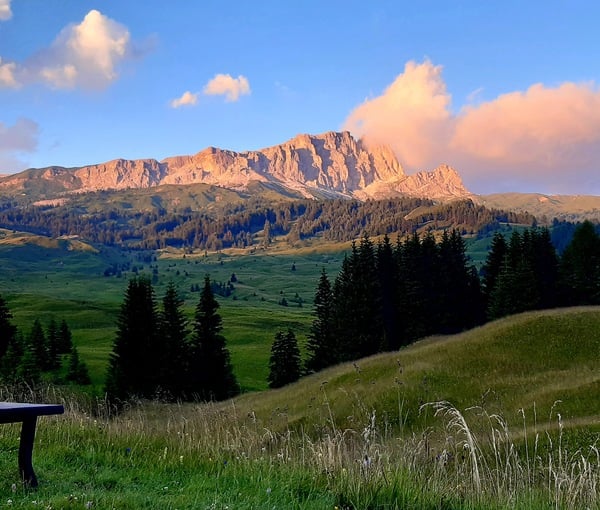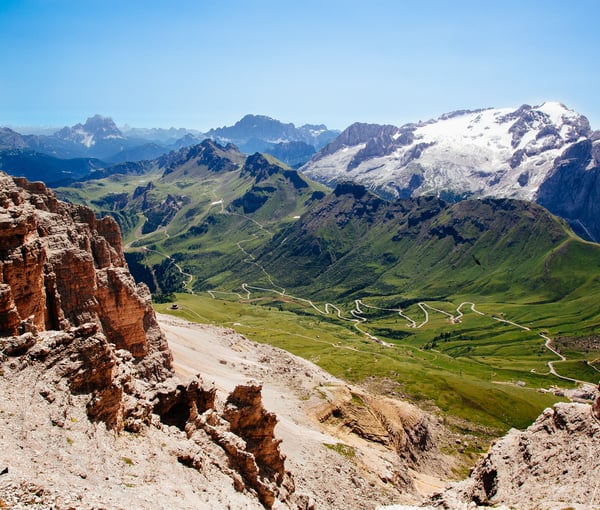UNESCO World Heritage Site: the Dolomites, unique in the world
Arabba, called "Rèba" in the "Ladin" language, is located at an altitude of 1,602 metres and is the most important town in the Fodom Valley. It lies at the foot of the imposing Sella and Col di Lana massifs.
The Dolomites mountain range is located on the south-eastern border of the Alps and is divided between the regions of Veneto (provinces of Belluno, Vicenza and Verona), Trentino-Alto Adige and Friuli-Venezia Giulia (provinces of Udine and Pordenone).
They consist mainly of carbonate rock and were formed in the Triassic period (about 250 million years ago) by the accumulation of calcareous algae, shells and corals, raised to over 3,000 m above sea level by Alpine orogeny.
They were discovered and studied between 1700 and 1800 by the French naturalist Deodat de Dolomieu. They were named Dolomites in his honour and are also called "Pale Mountains" because of the colour of the rock. They first appeared in written sources in 1864 in a travelogue by the English naturalists Churchill and Gilbert.
Despite the whiteness that distinguishes them from the surrounding rocks, the mineral of which they are composed has a high capacity to reflect light: hence the phenomenon of the "Enrosadira". At sunrise and sunset, when colours are more subdued, the rock absorbs them completely, making these vertical walls glow from pink to orange to fiery red, making sunrise and sunset a moment of total ecstasy.
Thanks to this feature, the world has realised the importance of protecting this earthly paradise and on 26 June 2009 the Dolomites were inscribed on the UNESCO World Heritage List.
The Dolomites are an extremely versatile environment in all seasons and offer a wide range of activities: skiing in winter, hiking, climbing, biking/mountain biking and car/moto driving in summer. But there is also room for those who love peace, quiet and relax: Meadows, forests and pastures that are green in summer, white and snowy in winter and full of nuances in spring and autumn, allow you to completely disconnect from everyday city life and have a unique experience.
The "Setsass" massif consists of two ancient overlapping atolls: the "Setsass" and the small "Setsass". Landmark for the history of geology, is one of the first areas studied in the Dolomites and is also called cliff "Richthofen"; the research carried out by this baron allowed to give substance to the theory of plate tectonics.
This mountain is very important from a geological point of view because it preserves the geometry of two cliffs with fossil underwater ramps and the connection with the deep sea deposits that surrounded them, the formation of "S.Cassiano".
They consist mainly of carbonate rock and were formed in the Triassic period (about 250 million years ago) by the accumulation of calcareous algae, shells and corals, raised to over 3,000 m above sea level by Alpine orogeny.
They were discovered and studied between 1700 and 1800 by the French naturalist Deodat de Dolomieu. They were named Dolomites in his honour and are also called "Pale Mountains" because of the colour of the rock. They first appeared in written sources in 1864 in a travelogue by the English naturalists Churchill and Gilbert.
Despite the whiteness that distinguishes them from the surrounding rocks, the mineral of which they are composed has a high capacity to reflect light: hence the phenomenon of the "Enrosadira". At sunrise and sunset, when colours are more subdued, the rock absorbs them completely, making these vertical walls glow from pink to orange to fiery red, making sunrise and sunset a moment of total ecstasy.
Thanks to this feature, the world has realised the importance of protecting this earthly paradise and on 26 June 2009 the Dolomites were inscribed on the UNESCO World Heritage List.
The Dolomites are an extremely versatile environment in all seasons and offer a wide range of activities: skiing in winter, hiking, climbing, biking/mountain biking and car/moto driving in summer. But there is also room for those who love peace, quiet and relax: Meadows, forests and pastures that are green in summer, white and snowy in winter and full of nuances in spring and autumn, allow you to completely disconnect from everyday city life and have a unique experience.
The "Setsass" massif consists of two ancient overlapping atolls: the "Setsass" and the small "Setsass". Landmark for the history of geology, is one of the first areas studied in the Dolomites and is also called cliff "Richthofen"; the research carried out by this baron allowed to give substance to the theory of plate tectonics.
This mountain is very important from a geological point of view because it preserves the geometry of two cliffs with fossil underwater ramps and the connection with the deep sea deposits that surrounded them, the formation of "S.Cassiano".









